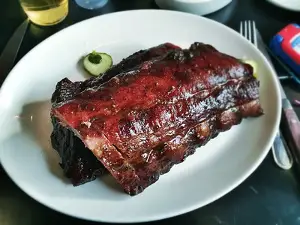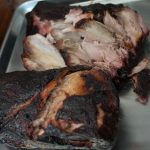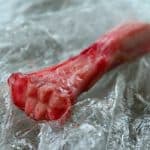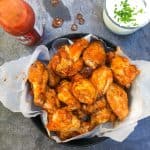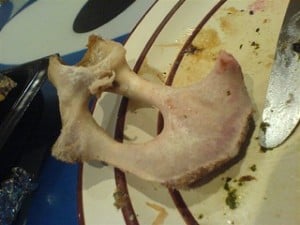
The focus of my article today provides one of those moments that we have as dog parents.
When our first reaction is a wave of panic that sweeps over us and is quickly followed by the self recrimination and guilt as we think, why did I let that happen?!
Today I want to talk about what happens (and what to do) when our dog eats a bone and then starts to vomit..
For all of you dog owners out there, welcome to that sinking feeling!
My dog ate a lamb bone and is throwing up. What should I do?
If your dog vomits after eating a lamb bone, the best thing to do is to keep a close eye on them.
If you dog only gags and vomits for a few seconds and brings the bone back up..
..and then trots off and seems absolutely fine, then it is safe to say that your dog has had a lucky escape.
If your dog keeps gagging and trying to vomit (and it goes on for minutes not seconds) then this is a much more serious issue and you will need to phone your vet.
In all likelihood the bone has got stuck somewhere in your dog’s digestive system and they need to see a vet as soon as possible.
Can lamb bones make dogs sick?
This is a little complicated so stay with me.
A lamb bone is no more likely to make your dog sick than any other type of animal bone, for instance pork bone unless your dog has a slight allergy to a particular meat.
My two golden retrievers seem to be extra sensitive to lamb and pork bones.
It is not that it makes them vomit though, just that it gives them a nasty dose of diarrhea!
I have no real scientific evidence but lamb meat can have a little more fat content in it than other meats and I often wonder if that is what upsets my dog’s stomachs.
But, with all that said, it is much more likely that your dog was sick after eating a lamb bone because of something to do with the bone as opposed to the meat which was attached to it.
Why does my dog vomit after eating bones?
There are quite a few reasons why your dog or any other dog might throw up after eating a bone.
Let’s take a look at some of the big issues.
[1] Size matters
The size of the bone in comparison to the size of your dog’s mouth is an important consideration.
You see, if the bone was quite small it might be that your dog decided not to chew it and instead just “wolfed” it down.
What can then happen is that the bone can get stuck somewhere in the dog’s system, making them choke.
[2] Greedy pig
The next factor to consider, is how your dog eats bones.
It is linked closely to the point above because if your dog loves to take their time gnawing, chewing and licking a bone then they are less at risk of throwing up because the pieces that they swallow are probably smaller and there is more time between each piece of bone that is swallowed.
If your dog eats a bone as if he hasn’t been fed for a year, then this puts them at more risk.
Not only will he try to swallow bigger pieces of bone, but the time between each mouthful is much less.
Which puts your dog at much greater risk of choking.
[3] Raw bones are better
Cooked bones are more dangerous for our dogs than raw bones.
This is because cooked bones are more brittle and they are at greater risk of splintering as the dogs chew them.
Splinters can be like daggers once they are swallowed and these sharp pieces could cut your dog’s digestive system as they travel through.
[4] Too much of a good thing
Another reason that your dog might throw up after eating a bone has nothing to do with the dangers of it splintering or of it causing an obstruction within your dog’s digestive system.
It could be because your dog has eaten too much bone.
And if they aren’t used to eating bones very often it could be that the ingredients are too rich and overwhelm their system.
A quick look at the nutritional data of a lamb rib shows that the largest ingredients are fat and protein.
A lamb rib has 30% fat and about 21% protein and so it could be that your dog has overdosed on either of those two…
[5] Weight bearing
Following on from discussing how raw bones are less brittle than cooked bones, weight bearing bones from an animal are better for your dog than non weight bearing bones.
Let me explain a bit more.
A leg bone from a lamb will be safer for your dog to eat than a rib bone from a lamb.
This is because bones from the legs of animals are tougher and less likely to break and splinter than non weight bearing bones.
A leg bone from a cow is safer for your dog than a rib bone from a cow.
And so on….
Do bones dissolve in a dog’s stomach?
A dog’s stomach is designed to digest bones.
Their stomach is very acidic with a pH level that during digestion can reach well below pH 1.0– which is a similar strength to “battery acid.
A reasonable guess seems to be that a bone can be digested by a dog within an hour or so.
What is interesting is that a dog seems to be able to control the strength of the acid in its stomach lining, depending on what it is trying to digest.
And so, if it was just digesting dry kibble, the pH should be higher and less acidic.
This begs the question, what protects the insides of a dog when it’s stomach acid is so strong?
And the answer it seems is loads of mucus!
What are the benefits of raw lamb bones?
There are two potential benefits that chewing raw bones can have for your dog.
Firstly are the nutrients that your dog gains from chewing on the bone.
These include calcium and phosphorus.
Secondly, is the potential mental stimulation, a sort of well being if you will, that your dog gains from chewing on a bone.
How can I use cooked bones with my dog?
Now after all of this you might be a bit upset.
Perhaps the idea of throwing cooked bones into the trash without “recycling” them via your dog, might be hard for you to swallow.
After all, you hate waste.
The good news is that there is a way of safely using cooked bones with your dog and that is by making a bone broth for them.
A bone broth is made by cooking bones in boiling water for hours and hours.
I have written articles about how to make and prepare bone marrow broth for your dog.

